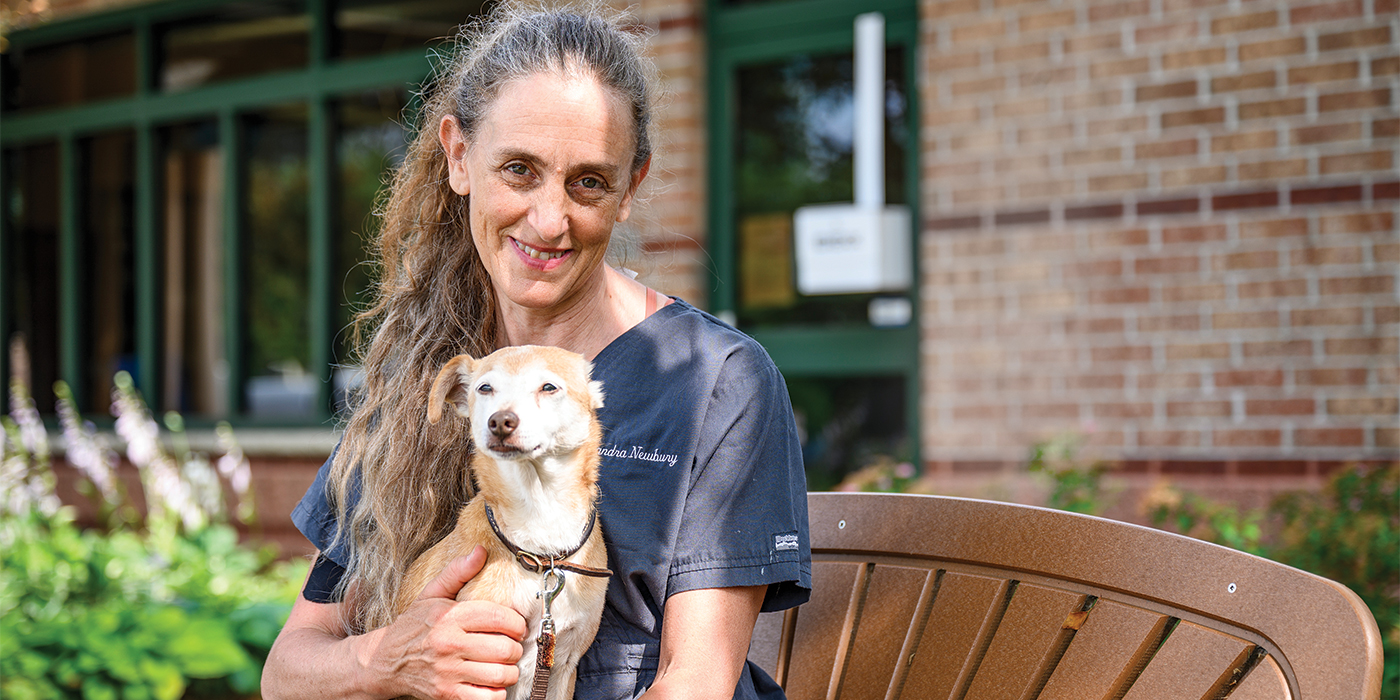
It’s About the Animals — and Humans, Too
UW–Madison’s Shelter Medicine Program provides a needed resource for at-risk animals and those who care for them each day.
I sit next to Sandra Newbury DVM’03 in her silver Subaru hatchback — Peanut, her 14-year-old rescue pup, is in the backseat — as she tells me about her weekend in northern Wisconsin.
“I’m a white-water kayaker, so I go up north almost every weekend,” she says, adding that she kayaks elsewhere in winter.
It’s a Wednesday morning in October 2019, and we are en route to an animal shelter in Illinois, where Newbury — the director of UW–Madison’s Shelter Medicine Program — will meet with a group of fellows who are there to learn how to improve the welfare of shelter animals.
Known as the Northern Tier Fellowship, it’s one of several efforts that the program, housed within the UW’s School of Veterinary Medicine, carries out for veterinarians and shelter leaders around the world. Started more than five years ago by Newbury, the program is a leader in the relatively new field of shelter medicine, which focuses on caring for animals in need. The program conducts its work through education and outreach-based research — findings based on work with shelters rather than through clinical trials. Each year, this particular fellowship invites shelter directors and managers in northern states to visit shelters that the program has previously worked with to gain exposure to new ideas and practices that help improve animals’ lives.
Among the many practices covered during the fellowship, the program staff emphasize an unexpected point: in what can be an emotionally taxing field, human welfare is critical to improving animal care.
Give Shelter
The Shelter Medicine Program is a national leader — but it wouldn’t be at UW–Madison without the assistance of private support.
“My position is one of the only UW Shelter Medicine positions that’s funded by the university,” says program director Sandra Newbury. “The rest of the program is funded through donations.”
Deep commitment to the program by Dean Mark D. Markel, the School of Veterinary Medicine, and the university impressed philanthropic partners. Because the university was supporting the primary faculty position, foundations and donors stepped in to offer additional support. Almost instantly, the UW’s Shelter Medicine program became one of the most respected in the country. Jeff ’83 and Sara ’85 Wiesner, who had previously supported the program through a scholarship, established a shelter medicine endowment, making the UW program one of only a handful in the country with this type of support. After Newbury was hired, Margaret A. Cargill Philanthropies (MACP) invited the UW to apply for a grant to help establish a shelter medicine outreach program that, today, is national and international in scope. UW Shelter Medicine is honored to work in strategic partnership with MACP in its animal welfare funding. Maddie’s Fund, a family foundation, has funded the program’s educational branch and outbreak response work, supporting fellowships, internships, residencies, and a shelter medicine rotation for veterinary medical students.
With this financial help, the UW program has been able to train the next generation of shelter medicine veterinarians and leaders and is able to help shelters around the country face disease outbreaks. “That’s one of the most important things I think we do as a program is really offer sound diagnostic testing and interpretation to animal shelters,” says Newbury.
The program, Newbury notes, “has really been an amazing philanthropic partnership.”
John Allen and Stephanie Haws ’15
It’s a Balance
Back in the car that afternoon, Newbury, Peanut, and I return to Madison to meet a second group of fellows at the Dane County shelter. This time, Peanut shares the backseat with three mewing kittens, who are being transferred to help lower the Illinois shelter’s cat population. The kittens — whose mother no longer wanted them — will receive the attention they need at the Dane County shelter.
That morning, Newbury demonstrated to fellows how to identify and manage overpopulation; she noticed that the shelter’s number of cats was over capacity and made recommendations to lower it, such as starting a cat adoption sale and relocating the kittens to a different shelter.
Now on our drive to Madison, I learn that Newbury isn’t only a white-water kayaker — she is also a local circus performer and an aerial dancer, and she has a residency through the Overture Center for the Arts to teach circus arts to children at Madison’s Lussier Community Education Center. She decided to give circus performance a try after enrolling her son in classes.
“I’m pretty open about it,” she says of her hobbies. “I used to keep it secret, and then I was like, ‘I think people should know because everybody knows I work really hard at what I do, and I love what I do as a profession, but I also love these other things that I do.’ ”
Loving things outside of the profession is important. Although the reasons aren’t fully understood yet, veterinarians have high suicide rates. According to a 2019 study from the Centers for Disease Control and Prevention, female veterinarians are 3.5 times as likely and male veterinarians are 2.1 times as likely to die from suicide compared to the general population. Being open about her outside interests, Newbury says, is part of the program’s effort to teach veterinarians and shelter staff the value of work–life balance. She leads by example, and sometimes she will build in time for yoga and other activities during the fellowships.
“You can see how sheltering could really be consuming. A lot of the time, especially in shelter medicine, I think, people try to solve the problem,” she says, noting that workers will sometimes bring animals home rather than allow themselves distance from work. “What I try to teach, especially my veterinarians, is to balance their lives so that their career in sheltering will be sustainable and that they won’t just come in, work in shelters for a year, and be so burned out that they never want to help again.”
A Need for Structural Change
Formerly a full-time artist, Newbury was inspired to volunteer for a local shelter after seeing stray cats near her Chicago studio. As she gained more responsibility in the shelter, she saw firsthand veterinarians’ limited involvement and was concerned by their lack of knowledge about shelter care.
“At that time, there really weren’t veterinarians who were interested in animal shelters,” she says. “There was no such thing as shelter medicine.”
In addition, veterinarians working in shelters were often criticized for their role in making euthanasia decisions, especially those made to control crowding. No one wants to be called “Dr. Death,” and veterinarians would quit after a year, contributing to a shortage of professionals and creating a knowledge gap and missing skill set for animal care and welfare.
Even later on, as Newbury helped build a shelter medicine program at the University of California–Davis in the early 2000s, there was misunderstanding around what program staff meant when advocating for population management.
“People thought that all I wanted to do is euthanize animals,” Newbury says. “I got to a point where, when I would give presentations on this, I would say at the beginning, ‘If at any point you think I’m saying I want you to euthanize more animals, euthanize animals faster, or anything of the kind, please stop me and raise your hand, because I don’t mean that, and I want to try and clarify that right at the time.’ ”
Starting in her early years of working for a shelter, Newbury sought to counter the spiraling negative trends she was noticing. She created a protocol to make the most of the shelter’s limited veterinarian access, providing staff and volunteers with methods to try when a problem arose with one or more animals. If the protocol didn’t help an animal, that informed staff members that the animal needed the veterinarian’s attention — maximizing the veterinarian’s time and helping as many animals as they could, as quickly as possible.
“I realized pretty early on that what was needed were these structural changes to animal shelters, instead of just trying to deal with each individual problem — which of course doesn’t mean you don’t deal with the individual problem. It’s just a way of dealing with it more efficiently,” she says.
Even with the protocol, Newbury was frustrated by the shelter’s problems, such as outbreaks resulting from a veterinarian’s distrust of vaccinations in cats. That’s when she reached out to the UW’s School of Veterinary Medicine, seeking input from Ronald Schultz, now a professor emeritus in the Department of Pathobiological Sciences. “I decided I should go to vet school after all, because there needed to be veterinarians who knew about animal shelters,” she says. “I think if I had actually known that I wouldn’t be an artist [anymore], I don’t think I would’ve done it — but I’m glad I didn’t know, because I’m really happy with what I do.”
Following veterinary school, she became the medical director at the Dane County Humane Society before working for UC–Davis, where she helped build the first shelter medicine program at any university. (The director of that program, Kate Hurley, was the first in the world to become a resident in shelter medicine.) Although employed by UC–Davis, Newbury continued living in Madison and teaching at the UW. Meanwhile, a few other universities, such as the University of Florida and Cornell, started their own shelter medicine programs. Then, in 2014, Newbury was invited to apply for a grant that would soon create UW–Madison’s Shelter Medicine Program.
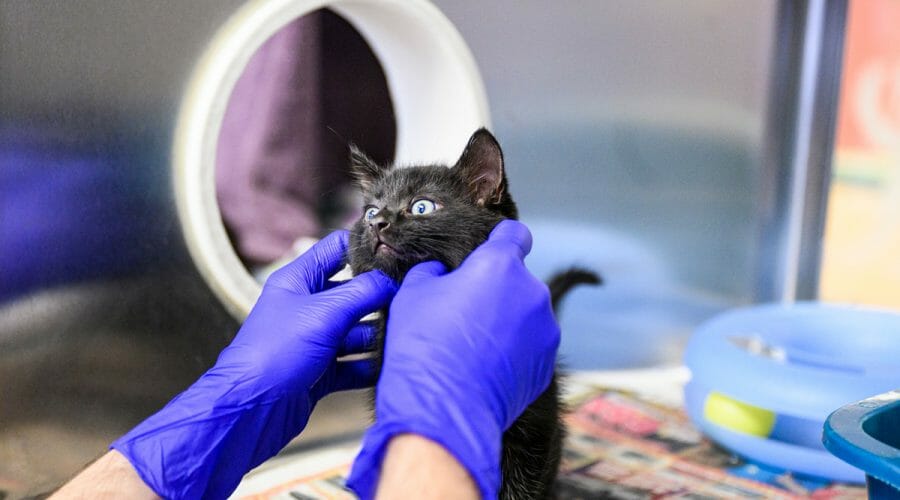
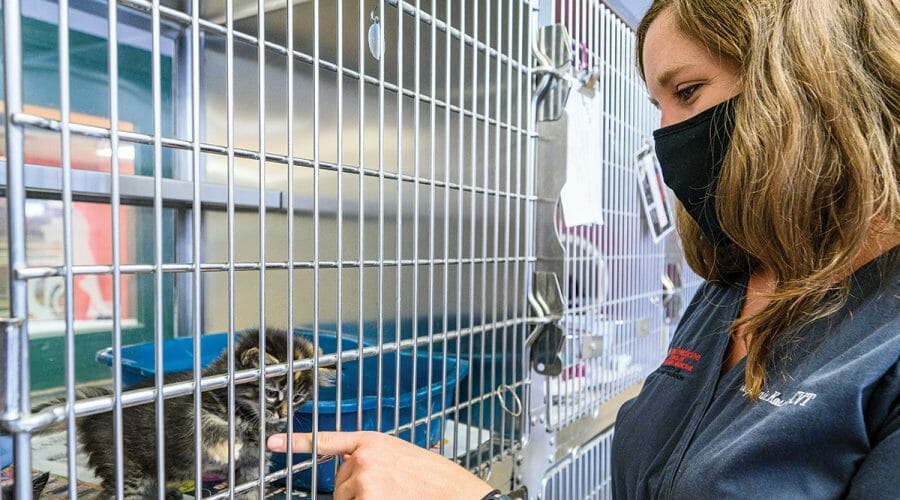
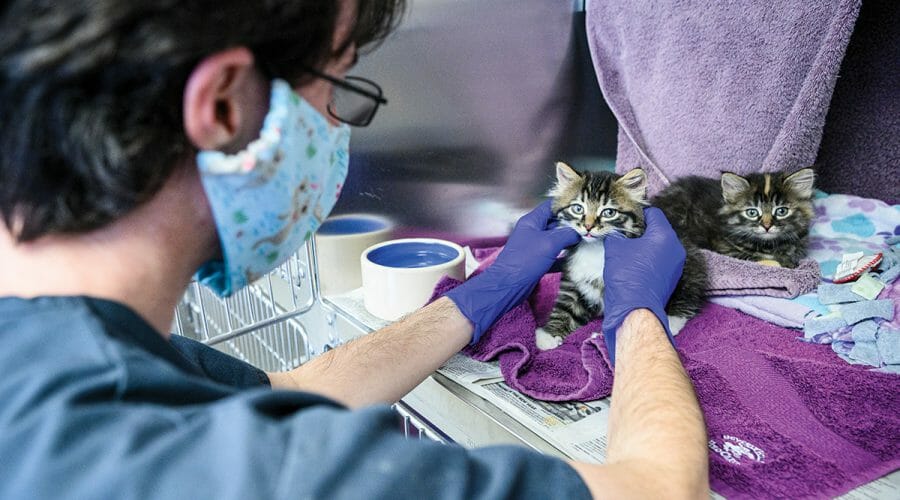
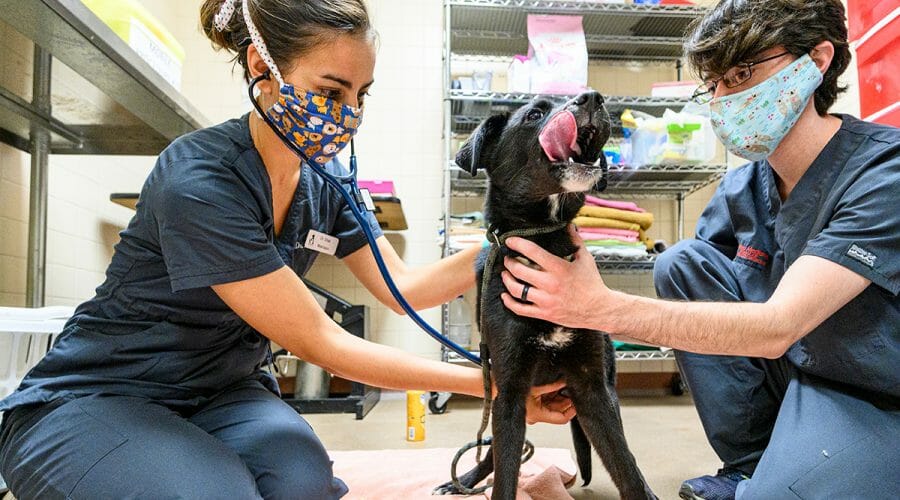
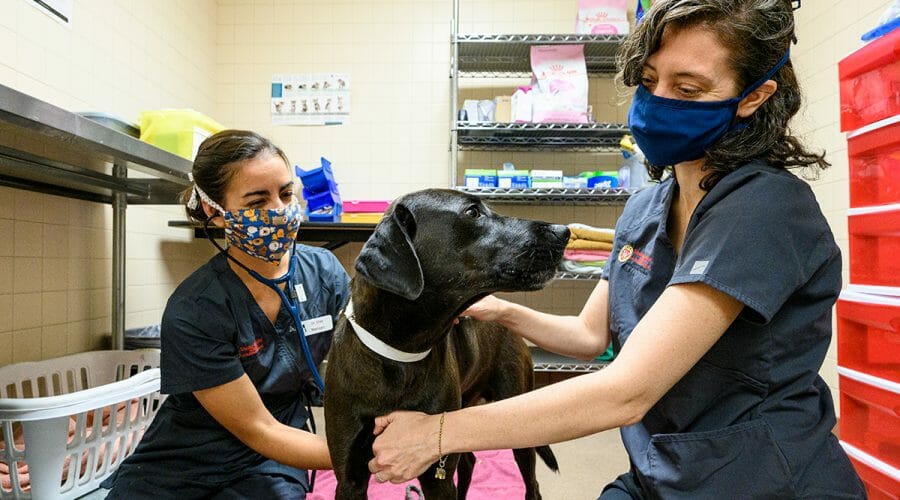
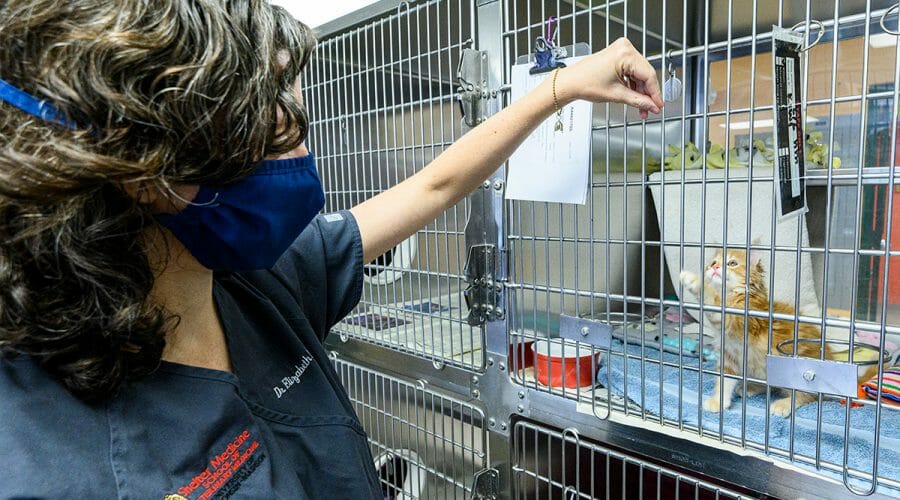
Limits to Superpowers
In a highly emotional field in which animals are in need of homes and at risk for health and behavioral problems, it’s natural to want to help every animal. However, this feeling can often translate into shelter staff members taking in more animals than they can manage, which may lead to ongoing problems. Today, the UW’s Shelter Medicine team provides veterinarians and staff with the guidance they need to increase adoption rates and improve animal care, while also helping them work within limits that set up both shelter animals and workers for success.
The program’s staff members teach shelters a series of best practices aimed at upping adoption rates and enhancing animal care, such as giving vaccinations upon intake, decreasing animals’ lengths of stay, and increasing shelters’ capacities for care. They also recommend making adoption applications and processes more approachable and less discriminatory; giving each animal separate spaces to eat and defecate; and offering preselection, permitting visitors to view animals and apply for adoptions before pets’ holding periods are over.
These efforts also mean setting limits, which can be counterintuitive, Newbury says. For instance, the program encourages staff to monitor pet intake and think critically about whether being in a shelter is the best choice for an animal.
“There is recent research to show that, for example, cats are significantly more likely to get back home if you just leave them where they are than if you pick them up and bring them to an animal shelter,” she says. “For a really long period of time, people would pick up every cat that was out walking around and bring it to an animal shelter, but national reclaim rates for cats were 1 to 2 percent.”
To help shelters implement these practices and function within their limits, the program empowers them to tailor practices to their individual needs. If a shelter does not have a full-time veterinarian, for example, the program works with staff members to enforce protocols that help them work efficiently.
“There are limits to your superpowers, and so you’ve got to be sure that you’re using them effectively,” Newbury says. “We talk a lot about making choices for how [shelters are] investing their resources and energy and time.”
When consistently executed, these methods help shelters stay in what Newbury calls the “positive cycle.” That means shelters adopt out animals more quickly, avoid overpopulating, and increase their capacities for care so staff are able to give more attention to each animal. This compares to a “vicious cycle,” in which shelters are not effectively managing these factors, leading to issues such as overpopulation and higher risks of infectious disease and behavioral problems in animals.
This approach helps shelters manage environments where stress levels can run high, as veterinarians and staff are required to make choices that can be matters of life and death for animals.
“Every time we [visit a shelter], it’s scary, but we’ve seen [our practices] work enough times that we believe, and we know, [they’ll] work,” Newbury says. “Even though it’s scary, it’s less scary than poor welfare and the chronic effects of poor welfare on the humans, the animals, and the population.”
A New Support Network
On the third and final day of the Northern Tier Fellowship, the full group of fellows reconvenes to discuss strategies in a conference room at the DoubleTree Hotel on West Johnson Street in Madison (where Peanut makes the rounds to say hello). Through these conversations, Newbury and her team not only give shelters recommendations for improving animal welfare, but also foster a support network that, not long ago, didn’t exist.
They allow time for the group to talk about what they observed the days prior and be candid about the hurdles they face at their own shelters. Some fellows express concerns about bringing the new practices back to teams who are resistant to change.
“I end up saying this once every fellowship: It is important to try what you’re trying,” Newbury says to the group. “It is also important sometimes to recognize that if a particular [person or organization] cannot be motivated, to not just stay and bang your head against the wall forever. Because your passion and your power are important in the field. If it turns out that you cannot effect change in your own organization, there are other organizations that will welcome you where it wouldn’t be so hard.”
As the discussion continues, Newbury emphasizes the support the program provides.
“One of our [past veterinarian] fellows once said that, when she was trying to implement a new recommendation at her shelter, she felt like there were 12 [veterinarian fellows and program staff members] standing behind her helping her. And we were just laughing. We were like, ‘There are. We’re here,’ ” Newbury says. “That is a huge reason that we started these fellowships.”
During a break, I speak with Marta Pierpoint, who attended the program’s inaugural Northern Tier Fellowship and returned as a mentor for its second year. She tells me it’s hard to count the number of ways the fellowship has helped her.
“You’re not only learning from the experts at the University of Wisconsin. You’re learning from your peers, and you’re taking away big-picture thoughts, and you’re also taking back small things that you can implement,” says Pierpoint, who is executive director at the Humane Society of Western Montana.
An attorney by training who practiced law for eight years, Pierpoint served as a longtime volunteer at the shelter before becoming its director. On her first day in the role, however, the shelter received dogs with distemper — something she knew little about at the time. “That is how I was connected with Dr. Newbury, and she was incredibly helpful to our shelter and to me personally in getting through that.”
Now, as a mentor, Pierpoint can use the knowledge she’s gained from the program to help other shelters in her area, further expanding the support network. And if she has any questions, she knows whom to call.
“I have no hesitation if I have a question — whether it’s medical or administrative — I know that I can pick up the phone and call [the program],” she notes. “And that kind of professional support is priceless.”
At the conclusion of the fellowship’s final day, Newbury says she’s “overwhelmed” with happiness knowing that the fellows will leave feeling more knowledgeable and empowered to make change at their shelters.
“[Our work is] about the animals, but these are great people, and they’re trying so hard to do these amazing things, and so whatever we can do to support [them] is incredible to me,” she tells me. “There is so much emotion surrounding the field of sheltering.”
As we sit, surrounded by fellows chatting before heading home, I can’t help but notice the camaraderie among the group. It’s difficult to believe most of them had just met in the course of the three-day fellowship.
And I’m not the only one who notices.
“I mean, look around, everybody’s so happy, they’re all talking to each other. It’s so nice to see that,” Newbury says. “This is a safe place.”
Stephanie Haws ’15, a staff writer for On Wisconsin, wagged her (fictitious) tail at the chance to report this story.
Published in the Fall 2020 issue
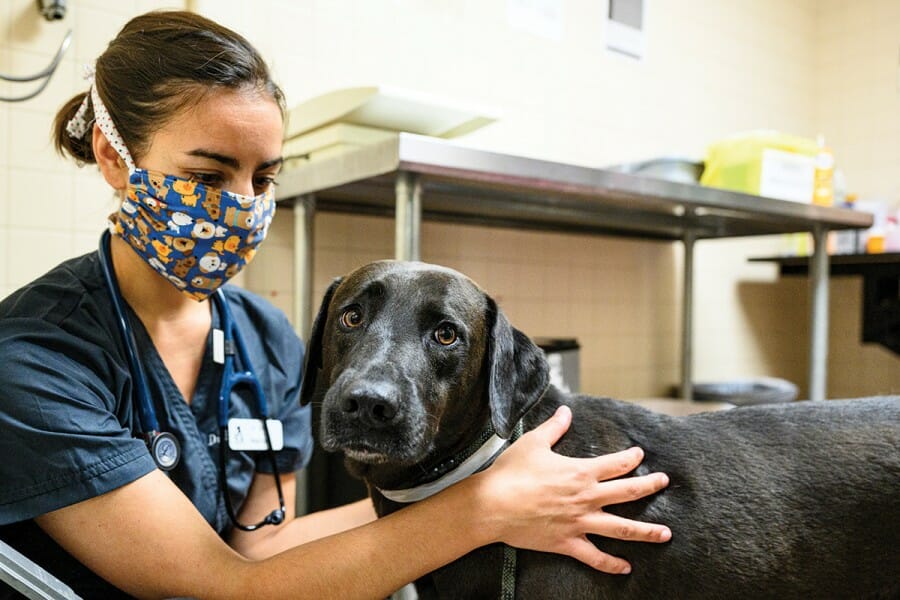
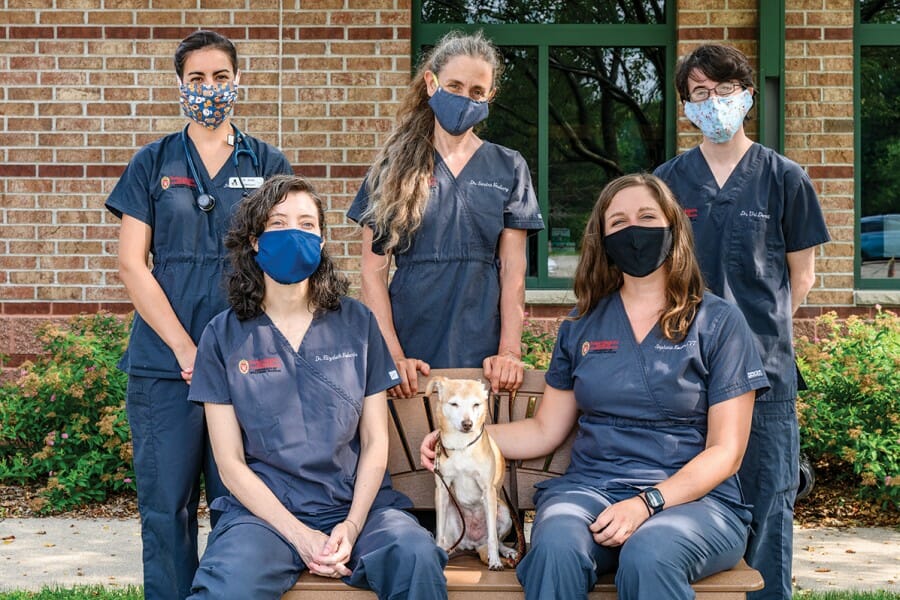



Comments
No comments posted yet.